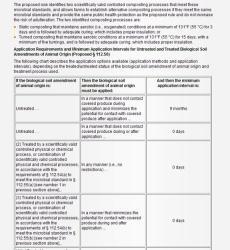On the other hand, speaking of manure, all the E. coli food poisoning cases a few years back got the "Food Safety and Modernization Act" passed. I asked my legislator not to support it, or at least make it not apply to small market growers, but she was gung-ho for safety and modernization.
She didn't think it was a way for agribusiness to put pressure on small growers who didn't know how to comply with FDA paperwork.
Funny how fast gardening and farming get into politics!
FSMA might be overkill, but what do I know? Sorry these are not newbie level quotations! If I were you, I would till in a few inches in early spring, and just not harvest for the first few weeks or month, and/or wash leafy things carefully. Like, being somewhat more careful than gardeners have been for the last 5,000 years with good results.
Or just plain not worry about it. I wish other home gardeners with manure experience would chime in!
The FSMA includes some standards about manure, but you were already probably not going drop horse patties among lettuce plants, hit it with a hard water spray, and then eat the lettuce the same day.
Food Safety Modernization Act of 2010 (H.R. 2751)
http://en.wikipedia.org/wiki/F...
http://www.fda.gov/Food/FoodSa... Biological Soil Amendments: Subpart F
Currently, within the U.S., composting of animal manure is not specifically regulated by any federal agency with respect to the safety of its use in the broad production of all produce. Instead, state and local regulations in some cases provide oversight, but this varies in scope and complexity
Establishes requirements for determining the status of a biological soil amendment of animal origin as treated or untreated, and for their handling, conveying, and storing (proposed §§ 112.51, 112.52);
Prohibits the use of human waste for growing covered produce except in compliance with EPA regulations for such uses, or equivalent regulatory requirements (proposed § 112.53);
Establishes requirements for treatment of biological soil amendments of animal origin with scientifically valid, controlled, physical and/or chemical processes or composting processes that meet or exceed specific microbial standards (proposed §§ 112.54 and 112.55);
Establishes application requirements and minimum application intervals for untreated and treated biological soil amendments of animal origin (proposed § 112.56); and
Requires certain records, including documentation of application and harvest dates relevant to application intervals; documentation from suppliers of treated biological soil amendments of animal origin, and scientific data or information relied on to support any permitted alternatives to requirements (proposed § 112.60).

